January 26, 2020 📊 Donald Trump changed the GOP. But has he weakened it?
Most voters who were Republicans—or Democrats—in 2016 have stuck with their party
Welcome! I’m G. Elliott Morris, data journalist for The Economist and blogger of polls, elections, and political science. Happy Sunday! This is my weekly email where I write about politics using data and share links to what I’ve been reading and writing. Thoughts? Drop me a line (or just respond to this email). Like what you’re reading? Tap the ❤️ below the title and share with your friends!
Dear Reader,
This week’s main read: I’m re-sharing a subscribers-only post from last week on the stability in Republican Party identification over the past four years. I think the point is important and worth sharing for everyone here.
Plus, others have published good work about identity and polarization, the urban-rural divide in political attitudes and the racial divide in ideology among Democrats.
Thanks all for reading my weekly email. Please consider sharing online and/or forwarding to a friend. The more readers, the merrier! If you’re shy, the best way you can support my newsletter is to press the heart button below the title (this makes it rank higher in Substack’s curation). If you’d like to read more of my blogging I publish subscriber-only content 1-3x a week on this platform. Click the button below to learn more!
—Elliott
Donald Trump changed the GOP. But has he weakened it?
Most voters who were Republicans—or Democrats—in 2016 have stuck with their party
One of the more famous studies in political psychology found that people will defer to their party when deciding which policy positions they do or do not support. In his aptly-titled 2003 paper “Party Over Policy,” Geoffrey Cohen writes:
Four studies demonstrated the impact of group influence on attitude change. If information about the position of their party was absent, liberal and conservative undergraduates based their attitude on the objective content of the policy and its merit in light of long-held ideological beliefs. If information about the position of their party was available, however, participants assumed that position as their own regardless of the content of the policy. The effect of group information was evident not only on attitude, but on behavior (Study 4). It was as apparent among participants who were knowledgeable about welfare as it was among participants who were not (Study 2). Important alternative explanations for the obtained results, such as effects of heuristic processing and shifts in scale perspective, were ruled out (Studies 3 and 4).
Cohen’s findings echo a broader theme in social-psychology research which stipulates that people change their minds when they face pressure from their social groups. It makes sense that liberals and conservatives would adopt the “orthodox” view for their party if they didn’t have dearly-held contrary beliefs, similar to how I might start watching more sports if that’s something my friends and family do.
This research has recently been expanded to include analyses of how we listen to our political leaders, particularly President Donald Trump. In a 2018 study, Michael Barber and Jeremy Pope found that the president possessed a unique ability to change the minds of his Republican supporters. If he endorsed a liberal policy position, they found, GOP voters were more likely to support it as well. Trump holds similar sway over them when endorsing conservative policies:
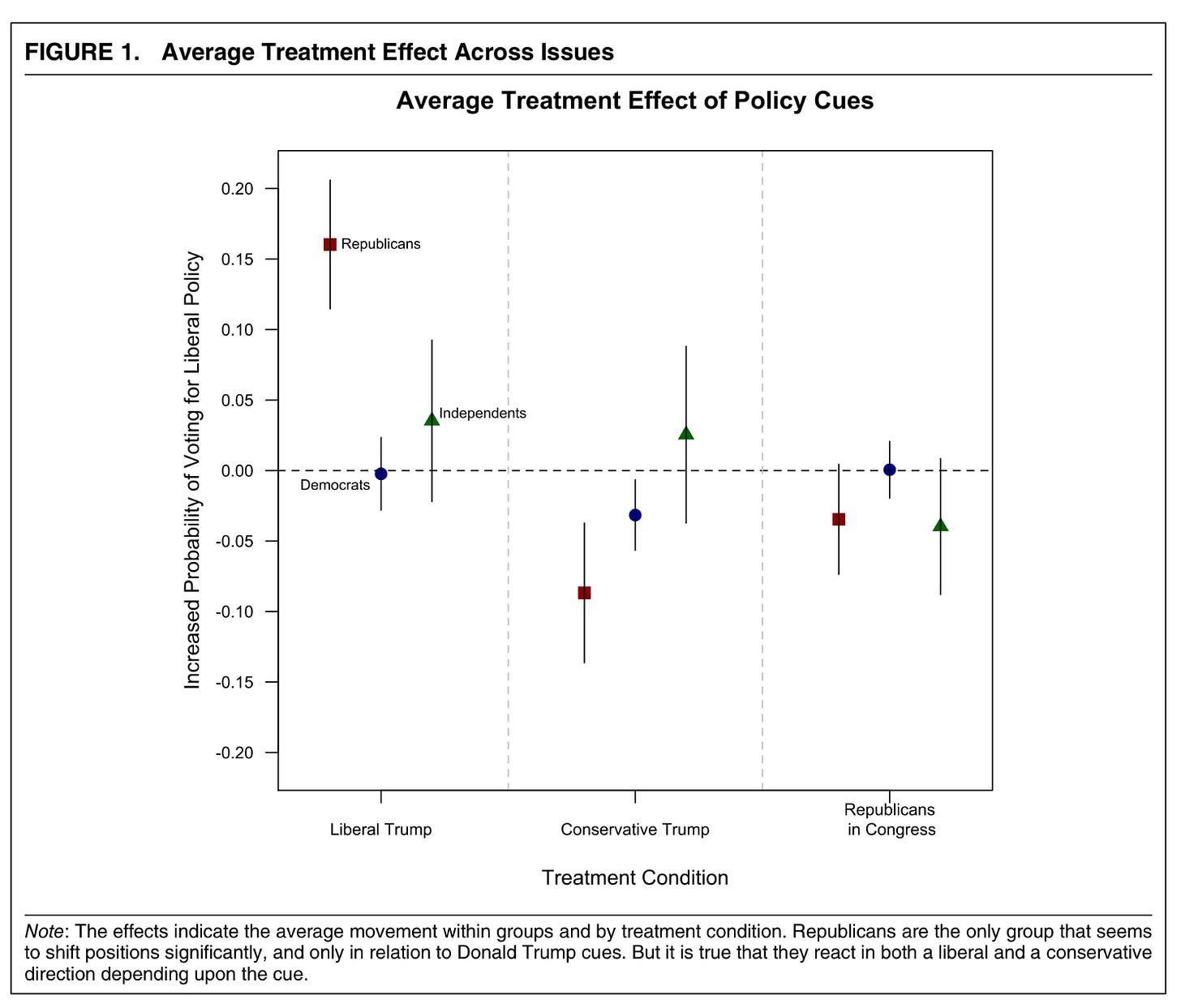
One might thus infer that an individual’s identity with or against Trump has more influence over things like policy preference and vote choice than their party identification. But that’s not exactly how this works. Though party and vote choice Are highly correlated they are not the same thing. There are, after all, a ton of self-proclaimed “Democrats” in the Southeastern United States who are vehement supporters of the president’s. Republicans are largely—though not always—Republicans first, and they hold onto that identity even when some of their other attitudes change.
It has therefore always been very surprising to me when people say that Trump has hurt the GOP by driving many of its voters away. There are very few Republicans who possess an anti-Trump (or #NeverTrump) identity. And given what Cohen, Barber and Pope tell us about the power of our social identities and group membership, it would be very odd indeed to see a max exodus from the party; more likely is that, as Trump became more popular with the GOP in 2015 and 2016, it became “standard practice” among Republicans to support him.
Well, it always feels good to have one’s priors confirmed, and that’s what I’m sharing with you today: prior-confirming research.
My buddy Alexander Agadjanian crunched some new data from a survey panel—a poll that re-interviews the same people over and over again—and found that the vast, vast majority of people who identified as a Democrat or Republican in 2016 still hold that identity. He tweeted thusly:

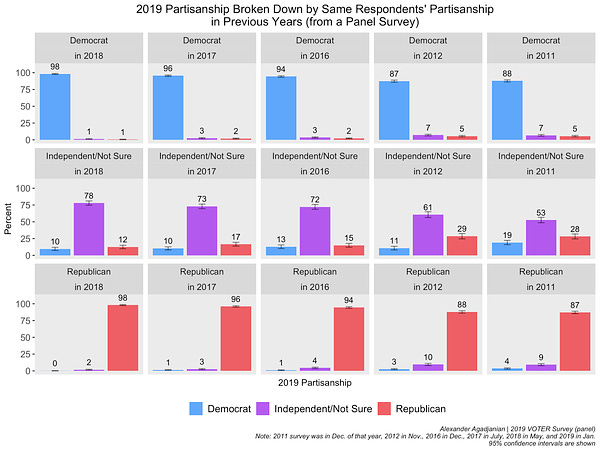
He also shared this graph of the correlation between party identification over different waves of the survey:
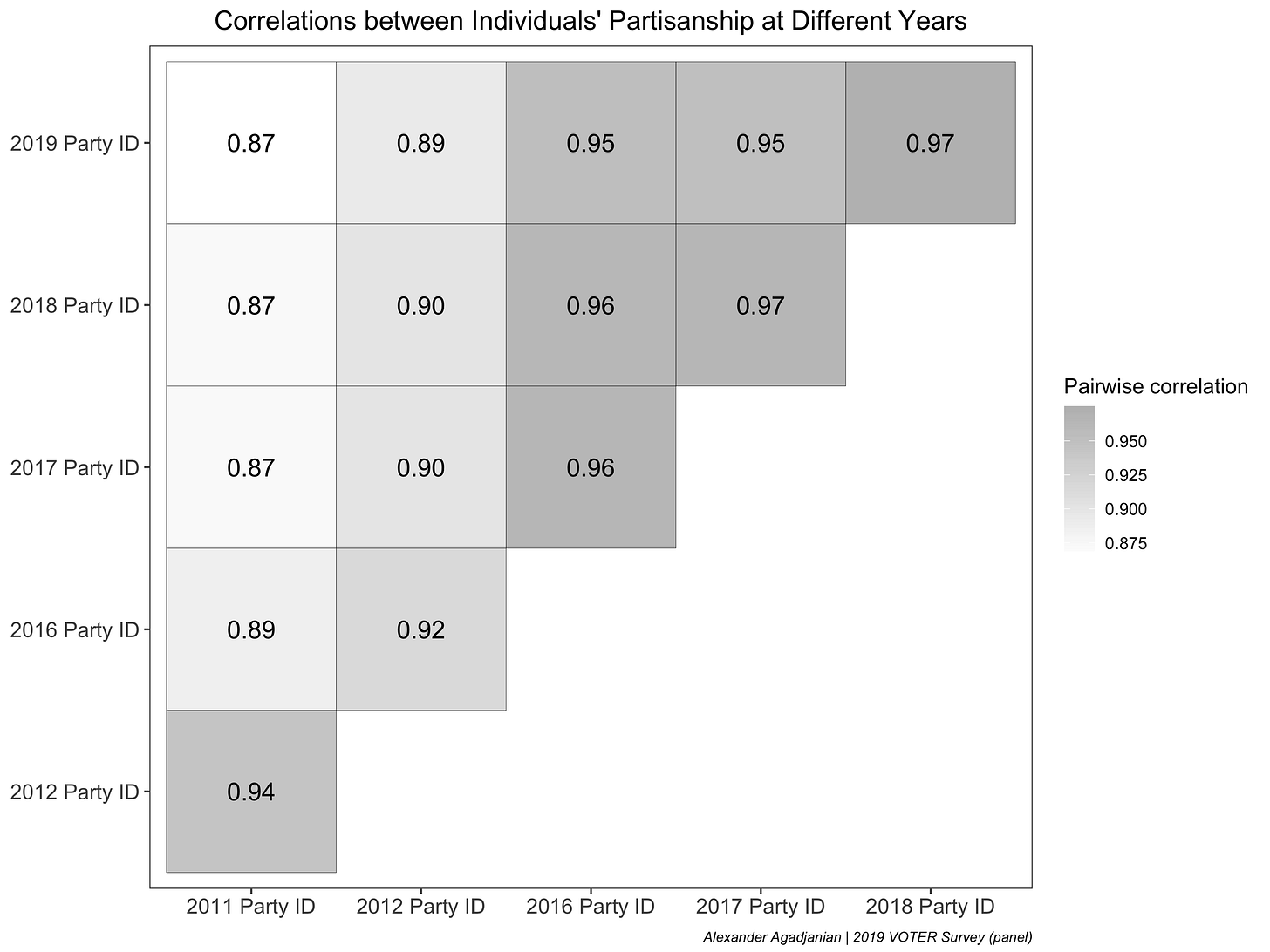
Alexander’s number-crunching revealed that roughly 95% of partisans in 2016 held the same identity in 2019. That obviously goes against the “Trump as a GOP-killer” thesis and with the “partisanship as a strong, dearly-held social identity” one. He also found that aggregate partisanship had held roughly steady over the same time period (a finding that is true across surveys). In fact, if anything we’ve seen an increase in the number of Republicans nationwide over the past four years.
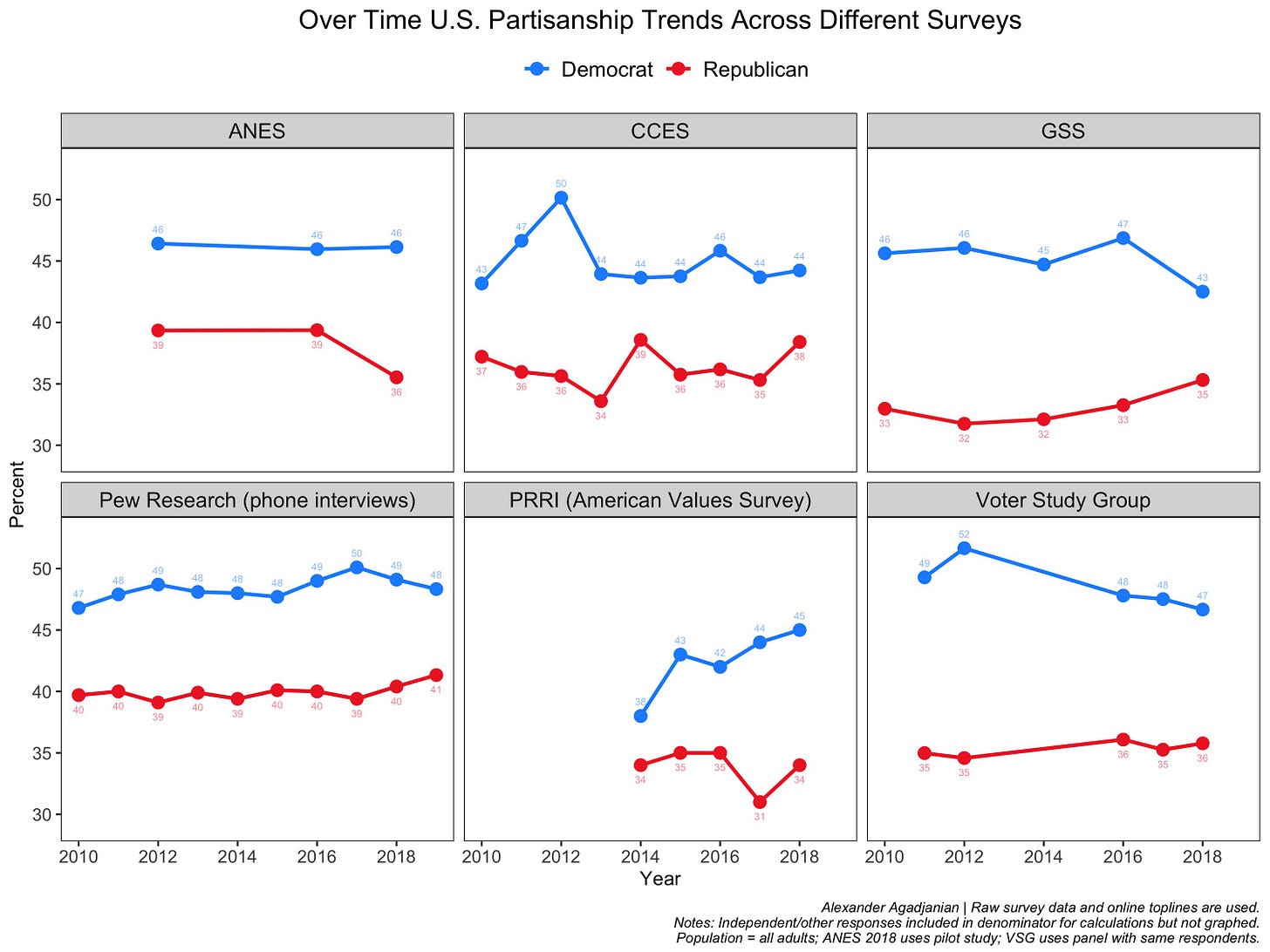
But let’s not get ahead of ourselves. These numbers are very relevant to our understanding of Americans as a whole, but there are a couple other factors to consider when gauging how they apply to elections. Namely: turnout.
Non-voters are much more anti-Trump than voters (see the below tweet with survey data), thanks mostly to being much younger than the people who actually turn up to the polls. So while the Republican Party is just as strong (at least on this measure) as it was in 2016, high turnout could send a bunch of New Democrats to the polls come November.
And here are some selected links to the work I read and wrote last week:
Posts for subscribers:
January 20: The polling error that could cause a big miss in Bernie Sanders’s favor. Some Iowa polls have weird samples of young people, and others look far too old. Are polls of “likely voters” to blame?
January 23: Donald Trump changed the GOP. But has he weakened it? Most voters who were Republicans—or Democrats—in 2016 have stuck with their party
January 25: How Bernie wins. His strength stems from a devoted base and a lack of consensus among moderates
Links and Other Stuff
This paper on urban-rural polarization was a good read
From James Gimpel, Nathan Lovin, Bryant Moy, and Andrew Reeves: “The Urban-Rural Gulf in American Political Behavior”:
Urban-rural differences in partisan loyalty are as familiar in the United States as they are in other countries. In this paper, we examine Gallup survey data from the early-2000s through 2018 to understand the urban-rural fissure that has been so noticeable in recent elections. We consider the potential mechanisms of an urban/rural political divide. We suggest that urban and rural dwellers oppose each other because they reside in far apart locations without much interaction and support different political parties because population size structures opinion quite differently in small towns compared with large cities. In particular, we consider the extent to which the compositional characteristics (i.e., race, income, education, etc.) of the individuals living in these locales drives the divide. We find that sizable urban-rural differences persist even after accounting for an array of individual-level characteristics that typically distinguish them.
Why we’re polarized
Francis Fukayama’s review of Ezra Klein’s upcoming book, which I’m very excited to read.
The increase in liberal Democrats has stalled
A good take on recent data from the Pew Research Center

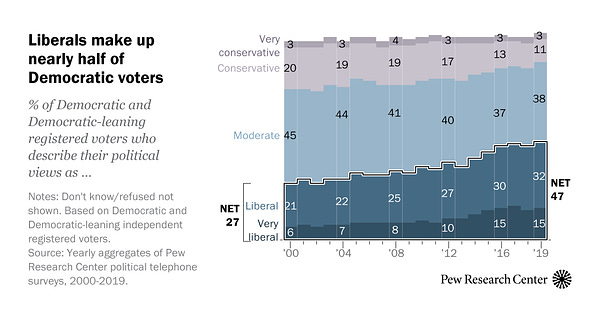
Why did Trump win?
There’s a good take on a new-ish paper over at Policy Tensor this week. I think he overstates the case against racial conservatism and anti-immigration attitudes as a cause for Trump’s election, but nevertheless think the conclusions from Grimmer and Marble are important and worth your time.
What I'm Reading and Working On
Last week, my buddy Alexander and I published a New York Times Op-Ed on our Twitter bot, @American__Voter, which profiles real Americans from survey data. It was fun and we think people might learn things from reading it.
I also wrote for The Economist on how white liberal voters have so far been the swing voters in the Democratic primary. That take is in our weekly US politics/2020 newsletter called “Checks and Balance”. Sign up today!
Next week is a busy one. I’ll have stuff on electability, Iowa, and ranked-choice voting. Stay tuned.
Thanks for reading!
Thanks for reading. I’ll be back in your inbox next Sunday. In the meantime, follow me online or reach out via email. I’d love to hear from you!
If you want more content, I publish subscribers-only posts on Substack 1-3 times each week. Sign up today for $5/month (or $50/year) by clicking on the following button. Even if you don't want the extra posts, the funds go toward supporting the time spent writing this free, weekly letter. Your support makes this all possible!



